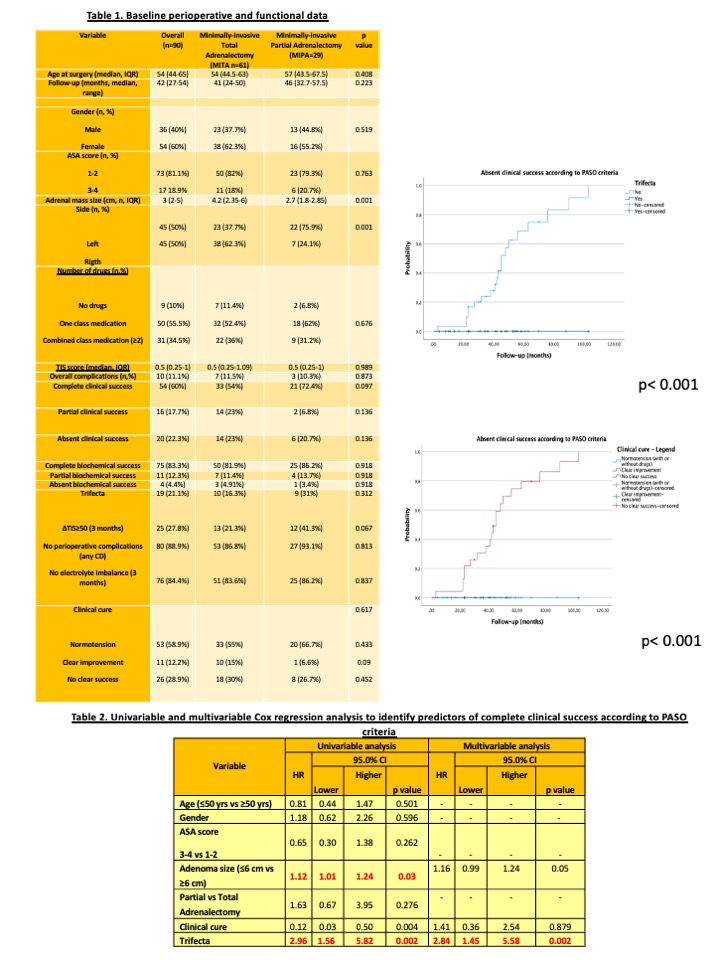Back
Poster, Podium & Video Sessions
Podium
PD04: Adrenal
PD04-05: Clinical cure vs a novel trifecta system for evaluating long-term outcomes of minimally-invasive partial or total adrenalectomy for unilateral primary aldosteronism: results of a multicentric series
Friday, May 13, 2022
7:40 AM – 7:50 AM
Location: Room 244
Umberto Anceschi*, Riccardo Mastroianni, Gabriele Tuderti, Alfredo Maria Bove, Aldo Brassetti, Mariaconsiglia Ferriero, Marilda Mormando, Rome, Italy, Alessandro Carrara, Trento , Italy, Bernardino De Concilio, Bassano del Grappa , Italy, Leonardo Misuraca, Rome, Italy, Orazio Zappalà, Trento , Italy, Cristian Fiori, Orb, Italy, Marialuisa Appetecchia, Rome, Italy, Antonio Celia, Bassano del Grappa , Italy, Francesco Porpiglia, Orbassano , Italy, Giuseppe Tirone, Trento , Italy, Michele Gallucci, Giuseppe Simone, Rome, Italy

Umberto Anceschi
IRCCS "Regina Elena" National Cancer Institute
Podium Presenter(s)
Introduction: In order to critically evaluate long-term functional outcomes of adrenal surgery for primary aldosteronism (PA), several predictive scores have been recently conceived. We compared a novel trifecta system that summarizes outcomes of adrenal surgery for Conn’ syndrome regardless the surgical technique with the standard clinical cure criteria proposed by Vorselaars.
Methods: A multicenter minimally-invasive adrenalectomy dataset was queried for “unilateral adrenal mass” and “primary aldosteronism (PA)” at 4 participating institutions between 2011-2021. Clinical and biochemical complete, partial and absent success rates according to PASO criteria were assessed for the overall cohort. Trifecta was defined as the coexistence of =50% antihypertensive therapeutic intensity score (TIS) reduction (?TIS) and no electrolyte impairment at 3-months after surgery, no Clavien-Dindo (2-5) complications. Probability of absent clinical success according to non-achievement of trifecta and clinical failure were estimated by Kaplan-Meier method, respectively. Cox regression analyses were used to identify predictors of long-term clinical success. For all analyses, a two-sided p<0.05 was considered significant.
Results: Out of 90 patients, at a median follow-up of 42 months (IQR 27-54) a complete, partial, and absent clinical success was observed in 60%, 17.7%, 22.3% of cases while a complete, partial and absent biochemical success was achieved in 83.3%, 12.3%, 4.4% respectively. Overall trifecta and clinical cure rates were 21.1% and 58.9%, respectively (Tab.1). On Kaplan-Meier analysis, both trifecta and clinical failure predicted higher absent clinical success rates (each p<0.001; Fig. 1,2). On multivariable Cox regression analysis, trifecta achievement (HR 2.10; 95% CI 1.13-3.90; p=0.018) was the only independent predictor of complete clinical success at long-term follow-up
Conclusions: Compared to clinical cure, trifecta can be used to differentiate patients who are likely to achieve a stable and complete clinical success after partial and total adrenalectomy from those who will need continuous surveillance after treatment due to persistent or refractory hypertension on the long run
Source of Funding: None

Methods: A multicenter minimally-invasive adrenalectomy dataset was queried for “unilateral adrenal mass” and “primary aldosteronism (PA)” at 4 participating institutions between 2011-2021. Clinical and biochemical complete, partial and absent success rates according to PASO criteria were assessed for the overall cohort. Trifecta was defined as the coexistence of =50% antihypertensive therapeutic intensity score (TIS) reduction (?TIS) and no electrolyte impairment at 3-months after surgery, no Clavien-Dindo (2-5) complications. Probability of absent clinical success according to non-achievement of trifecta and clinical failure were estimated by Kaplan-Meier method, respectively. Cox regression analyses were used to identify predictors of long-term clinical success. For all analyses, a two-sided p<0.05 was considered significant.
Results: Out of 90 patients, at a median follow-up of 42 months (IQR 27-54) a complete, partial, and absent clinical success was observed in 60%, 17.7%, 22.3% of cases while a complete, partial and absent biochemical success was achieved in 83.3%, 12.3%, 4.4% respectively. Overall trifecta and clinical cure rates were 21.1% and 58.9%, respectively (Tab.1). On Kaplan-Meier analysis, both trifecta and clinical failure predicted higher absent clinical success rates (each p<0.001; Fig. 1,2). On multivariable Cox regression analysis, trifecta achievement (HR 2.10; 95% CI 1.13-3.90; p=0.018) was the only independent predictor of complete clinical success at long-term follow-up
Conclusions: Compared to clinical cure, trifecta can be used to differentiate patients who are likely to achieve a stable and complete clinical success after partial and total adrenalectomy from those who will need continuous surveillance after treatment due to persistent or refractory hypertension on the long run
Source of Funding: None


.jpg)
.jpg)